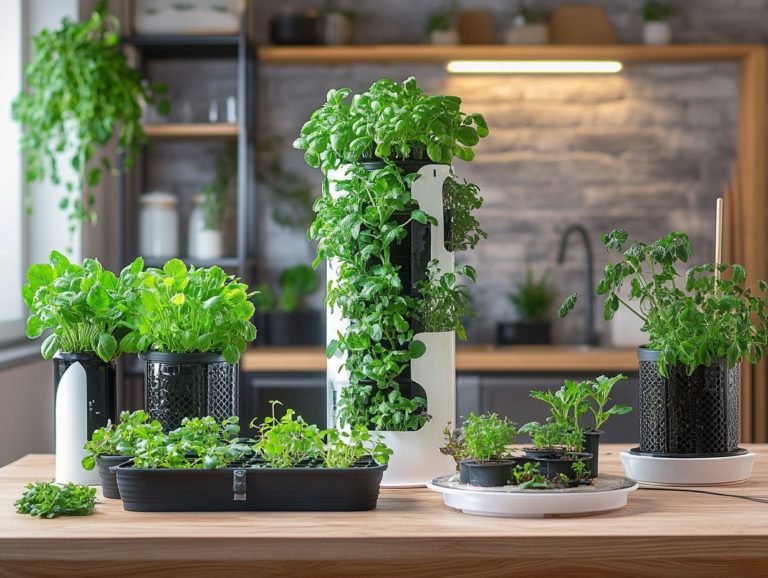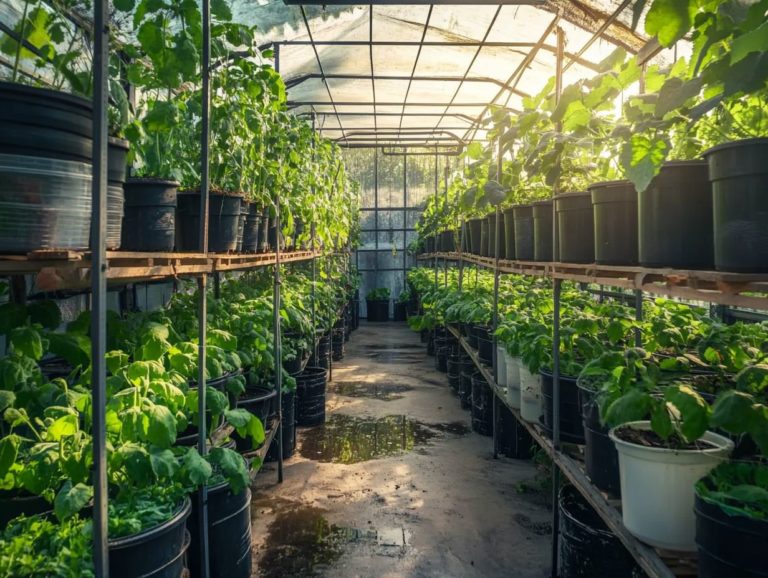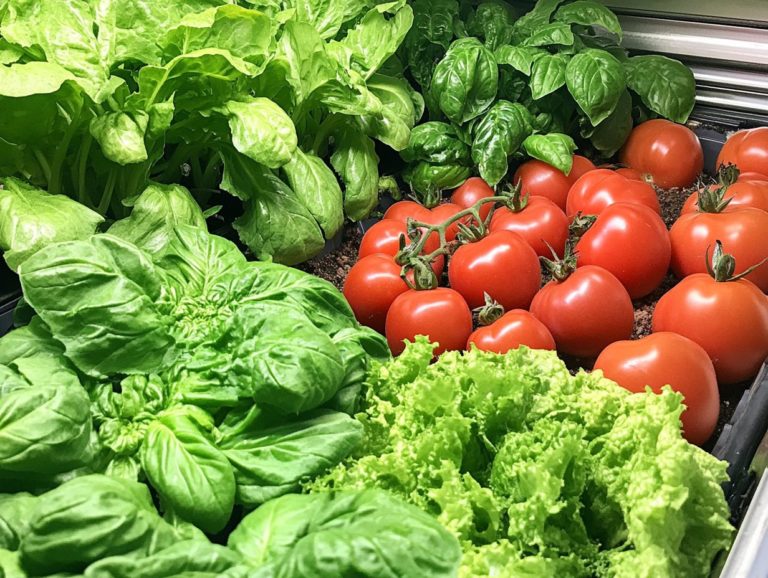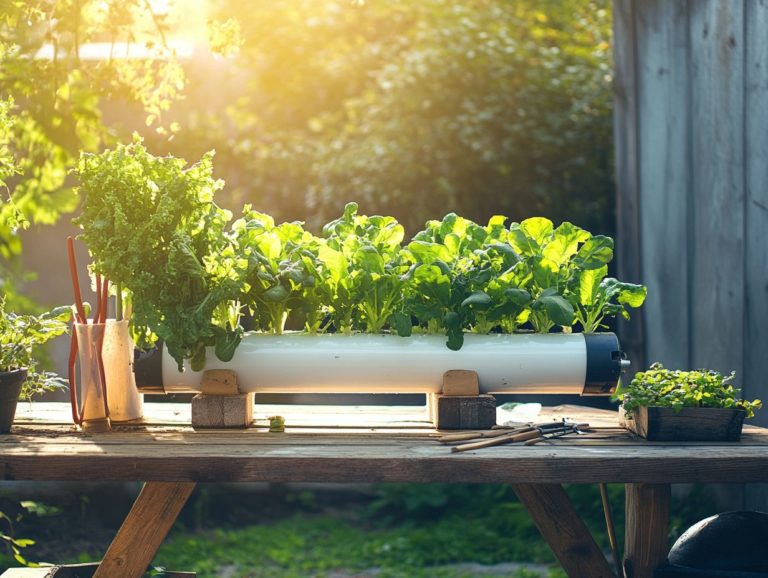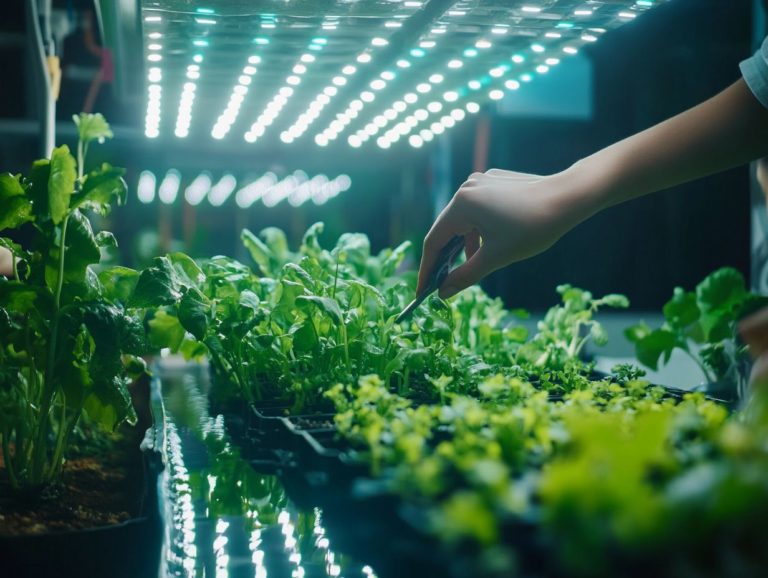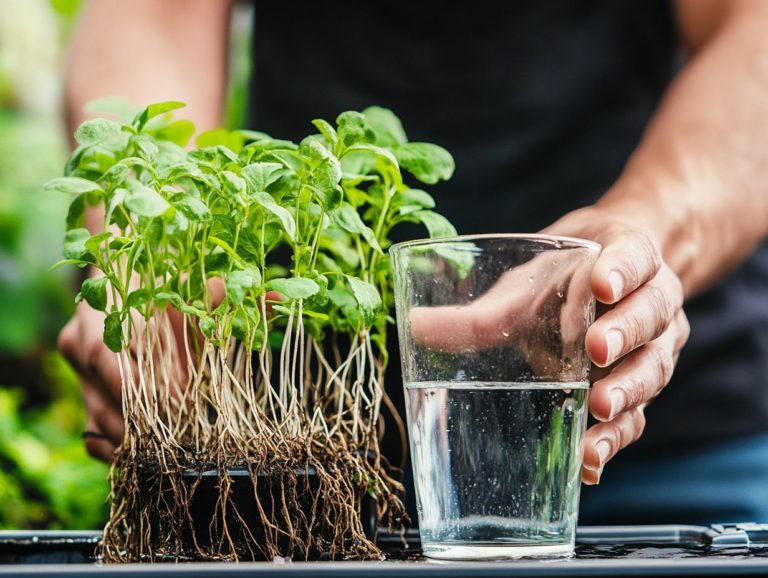What is Deep Water Culture in Hydroponics?
Deep Water Culture (DWC) is a hydroponic technique that allows you to cultivate plants in nutrient-rich water. It is a favored choice among gardening enthusiasts interested in hydroponic systems.
This article provides a high-level overview of the fundamental principles of DWC. It will guide you through its setup and reveal the benefits it brings to plant growth.
You ll also discover common pitfalls to steer clear of and see how DWC stacks up against other hydroponic methods.
Whether you re a seasoned grower or just starting out, you ll uncover valuable insights to elevate your hydroponic journey, including answers to common questions.
Contents
- Key Takeaways:
- How Does Deep Water Culture Work in Various Cultivation Methods?
- Benefits of Deep Water Culture
- Setting Up a Deep Water Culture System
- Common Mistakes and Troubleshooting
- Comparing Deep Water Culture to Other Hydroponic Methods
- Frequently Asked Questions
- What is Deep Water Culture in Hydroponics?
- How does Deep Water Culture work?
- What are the benefits of using Deep Water Culture in Hydroponics?
- What types of plants can be grown using Deep Water Culture?
- How do I set up a Deep Water Culture system?
- What are some common mistakes to avoid when using Deep Water Culture?
Key Takeaways:
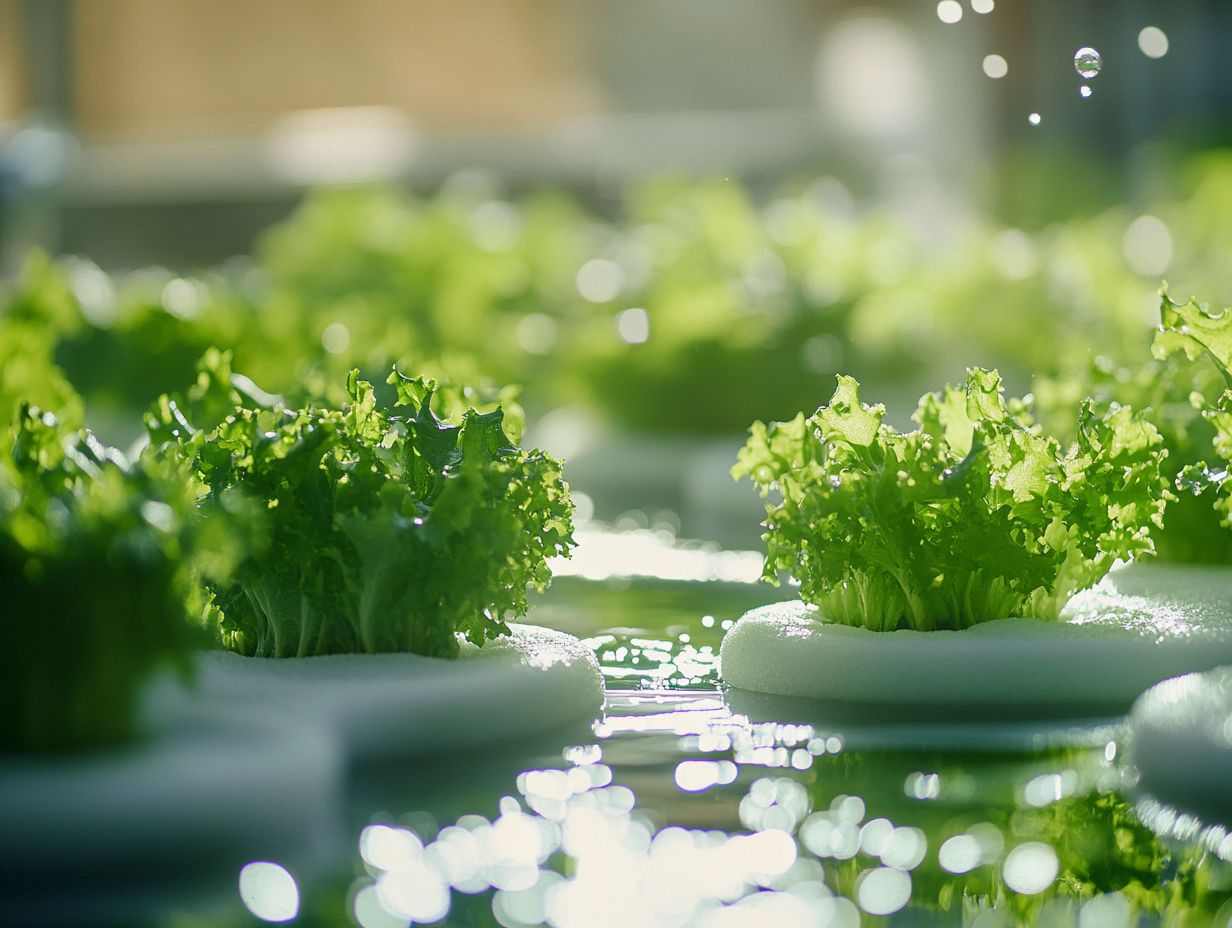
- Deep Water Culture is a hydroponic growing method where plants are grown in a nutrient-rich, oxygenated water solution instead of soil.
- The system provides a continuous supply of water and nutrients, resulting in rapid plant growth, larger yields, and low maintenance.
- Setting up a Deep Water Culture system involves simple steps and can be customized based on the size and needs of your plants. It’s important to avoid common mistakes and regularly troubleshoot for optimal results.
What is Deep Water Culture?
Deep Water Culture, or DWC for short, is a cutting-edge hydroponics method that lets you cultivate plants with their roots submerged directly in an oxygenated nutrient solution. This system is incredibly effective for quick plant growth and is favored in both home and commercial hydroponics setups.
It offers a streamlined way to grow a variety of plants, such as lettuce, tomatoes, and peppers. By keeping plant roots constantly nourished and oxygenated, DWC reduces your reliance on traditional soil-based gardening. This makes it an appealing choice for modern gardeners who appreciate low-maintenance options.
Emerging in the 20th century as part of the hydroponic revolution, Deep Water Culture has significantly evolved, providing numerous advantages for both novice and seasoned growers. You’ll love how simple it is! Just use air pumps and air stones, which introduce oxygen into the nutrient solution essential for fostering healthy root systems.
By boosting oxygen levels in the water, these components enhance nutrient uptake and promote vigorous plant growth while minimizing the risk of root rot and other common gardening issues. As the hydroponics sector continues to flourish, the importance of DWC is clear, driving advancements in sustainable agriculture and leading to greater yields.
How Does Deep Water Culture Work in Various Cultivation Methods?
Deep Water Culture allows you to deliver a continuous flow of oxygenated nutrient solution directly to the roots of your plants. This ensures they receive the essential water and nutrients necessary for optimal growth, which is vital for the success of any hydroponic system.
By employing an air pump and air stone, you can efficiently infuse oxygen into the water. This prevents the roots from drowning and fosters robust growth throughout all stages of cultivation.
Basic Principles and Components
The fundamental principles of Deep Water Culture focus on creating an efficient recirculating system that nurtures plant roots in water filled with nutrients and oxygen. Key components of this system include an air pump, air stones, and an appropriate growing medium to support your plants.
You need to carefully monitor the nutrient solution for pH adjustments and nutrient concentration to prevent issues like algae growth and ensure the health of submerged roots, especially during the seedling phase and beyond.
These systems typically feature robust reservoirs designed to hold the nutrient blend. Maintaining the right temperature is essential for optimal nutrient uptake. The air pump plays a vital role by continuously circulating oxygen through the solution, promoting root respiration and preventing stagnation.
By using air stones, you can finely disperse oxygen, ensuring it saturates the water effectively. Regularly checking water quality is crucial, as impurities can jeopardize delicate root systems and hinder growth.
Establishing a consistent monitoring schedule will empower you to swiftly adjust nutrient levels and pH, fostering the rapid development of lush, healthy plants.
Ready to start your hydroponic adventure? Dive into Deep Water Culture today!
Benefits of Deep Water Culture
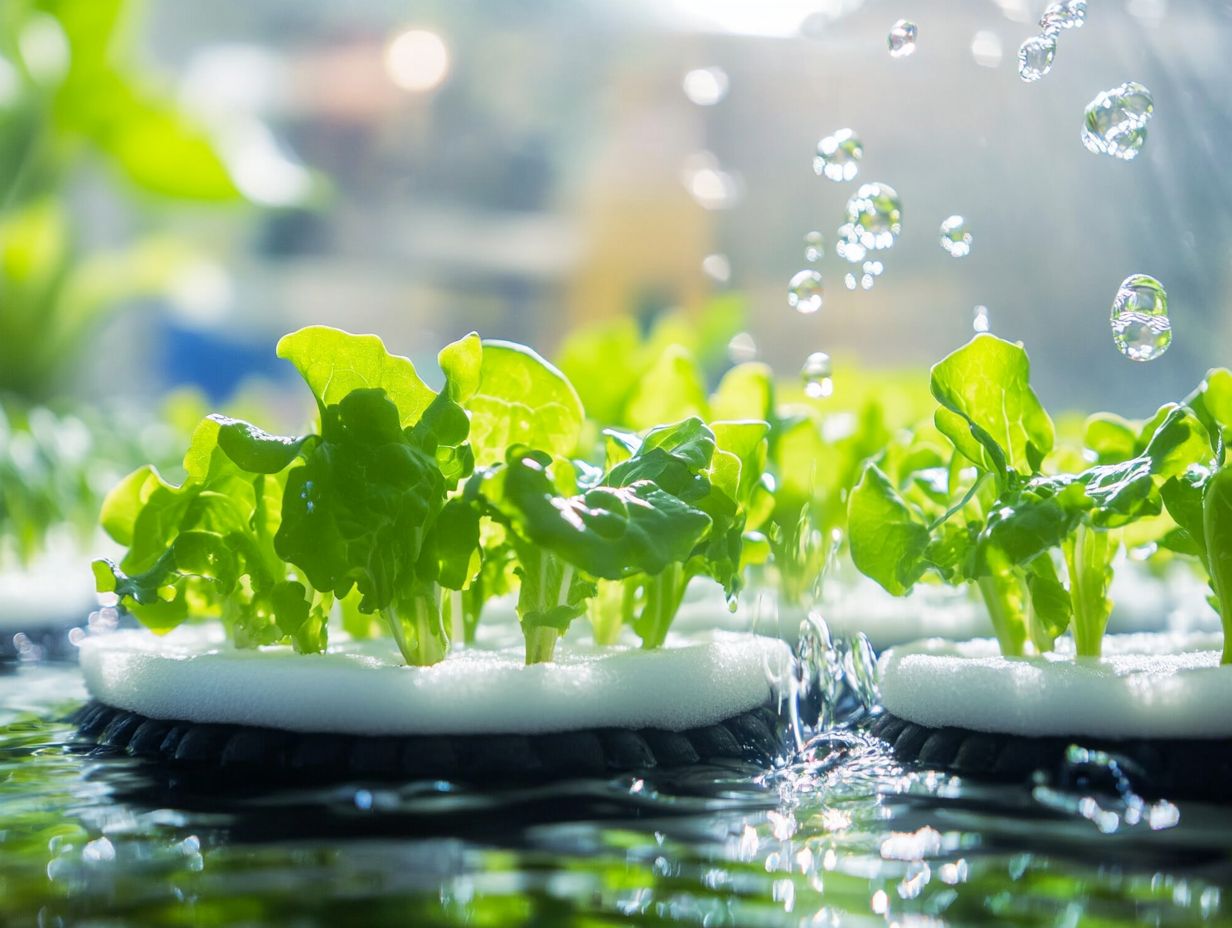
Deep Water Culture (DWC) presents a multitude of advantages, establishing itself as a favored option among hydroponic growers, especially in the realm of commercial hydroponics. Its capacity for fostering rapid plant growth and minimal maintenance requirements compared to traditional gardening methods sets it apart!
By utilizing water and nutrients efficiently, DWC systems ensure that plants receive uninterrupted access to essential elements. This consistent nourishment leads to healthier plants, which translates into higher yields and quicker crop cycles.
Advantages for Plant Growth and Maintenance
The advantages of Deep Water Culture (DWC) for your plant growth and maintenance are compelling. This method ensures optimal nutrient solutions and control! You’ll love the results. It promotes high plant health and rapid growth rates while significantly reducing the need for frequent upkeep.
With DWC, you can focus on adjusting the nutrient solution to meet specific light requirements and plant needs. This makes it a highly efficient choice for cultivating a variety of vegetables and herbs.
DWC shines in supporting diverse plants through all growth phases. Whether you’re nurturing seedlings or tending to fully mature crops, its capacity to maintain stable oxygen levels in the water significantly enhances root development. This is especially crucial for heavy-feeding crops like tomatoes and peppers.
DWC also tackles common gardening challenges, such as when plants can’t absorb nutrients, a frequent headache in traditional soil gardening. By enabling precise nutrient delivery, it ensures your plants receive exactly what they require, simplifying nutrient management.
The system’s adaptability lets you modify light exposure to meet your specific plant requirements, fostering better health and productivity.
Setting Up a Deep Water Culture System
Establishing a Deep Water Culture system requires careful planning. You want to ensure that your plants flourish in an environment where their roots bask in a precisely managed nutrient solution, all supported by an efficient air pump for optimal oxygenation.
As you embark on this journey, consider several key factors in the setup process. Selecting the ideal growing media, maintaining temperature control, and diligently monitoring the nutrient solution will help you cater to the specific needs of the plants you nurture.
Step-by-Step Guide
Setting up a Deep Water Culture system starts with selecting the right container for your nutrient solution. Ensure it s spacious enough to hold everything without sacrificing oxygen levels for those submerged roots. Next, install an air pump and air stones to ensure proper oxygenation.
This guide will walk you through choosing the right growing media and formulating the nutrient solution, making your transition from seedlings to thriving plant growth seamless.
Once you ve picked a reservoir that fits your plants while minimizing water evaporation, it s time to prepare that nutrient solution.
Use a high-quality hydroponic nutrient mix tailored to the specific needs of your plants. Follow the manufacturer s instructions to mix the solution while keeping an eye on the pH levels; they should ideally hover between 5.5 and 6.5 to promote optimal nutrient uptake.
Correctly installing the air pump is crucial. Place the air stones at the bottom of the container to create fine bubbles that efficiently enhance oxygen levels.
If you encounter challenges like insufficient oxygenation, troubleshoot by ensuring your air pump operates correctly and checking for any blockages in the air stones. Regularly monitoring the water temperature and nutrient levels will help you sidestep common issues, creating a healthy environment for your plants to flourish.
Common Mistakes and Troubleshooting

Common mistakes in Deep Water Culture can pose serious challenges for you as a grower, leading to problems with nutrient levels or insufficient oxygenation. These issues can pave the way for plant diseases and unwelcome algae growth.
Recognizing these pitfalls and mastering the art of troubleshooting is crucial to maintaining optimal growing conditions and ensuring your plants thrive in health and productivity.
Tips for Avoiding and Fixing Issues
To avoid and resolve issues in your Deep Water Culture system, it’s essential to regularly monitor the pH and concentration of your nutrient solution, along with the oxygen levels supplied by the air pump and air stones. This proactive approach helps prevent complications like algae growth.
By staying on top of these factors, you can maintain plant health and significantly enhance productivity in your hydroponic garden.
Keep a keen eye on light exposure for robust growth, especially during the growing phase. Adjusting the duration and intensity of light according to the specific needs of your plants is highly advisable, particularly when using Deep Water Culture (DWC) systems.
Addressing common challenges such as nutrient imbalances or root rot requires regular visual checks. Maintaining appropriate water temperatures is essential. Incorporating beneficial bacteria into your nutrient solution can combat disease, fostering a thriving environment for your plants.
Refreshing your nutrient levels is key! Regular water exchanges keep your plants thriving and healthy, especially during a nutrient solution change, further enhancing conditions for plant development.
Comparing Deep Water Culture to Other Hydroponic Methods
When you compare Deep Water Culture to other hydroponic methods like Bubbleponics and the Kratky Method, you’ll uncover distinct advantages and disadvantages that can significantly influence your choice based on your specific cultivation needs and available resources.
Each technique presents unique approaches to nutrient delivery and oxygenation, ultimately shaping plant growth and the overall maintenance of your system.
Pros and Cons
The pros and cons of Deep Water Culture (DWC) reveal its remarkable strengths in fostering rapid plant growth and requiring minimal maintenance. Yet, they also uncover some challenges, particularly regarding system setup and the critical need for temperature control.
When you compare it to other hydroponic systems like Bubbleponics and the Kratky Method, understanding these nuances is essential for you to make informed decisions that align with your gardening goals.
If fast growth is what you re after think leafy greens like lettuce or vibrant herbs DWC shines due to its oxygen-rich environment and readily available nutrients. However, it may not be the best choice for root crops like carrots or beets, where a soil-like environment can truly enhance flavor and texture.
Bubbleponics introduces an extra layer of aeration through bubbling, offering similar benefits but with the trade-off of requiring more frequent monitoring.
On the flip side, the Kratky Method stands out as an exceptionally low-maintenance option, ideal for beginners since it doesn t rely on pumps or electricity. Just keep in mind that while it s user-friendly, it may lead to slower growth rates compared to DWC in optimal conditions.
Ultimately, your choice among these methods will depend on the specific plant types you want to grow and your personal preferences as a gardener.
Frequently Asked Questions
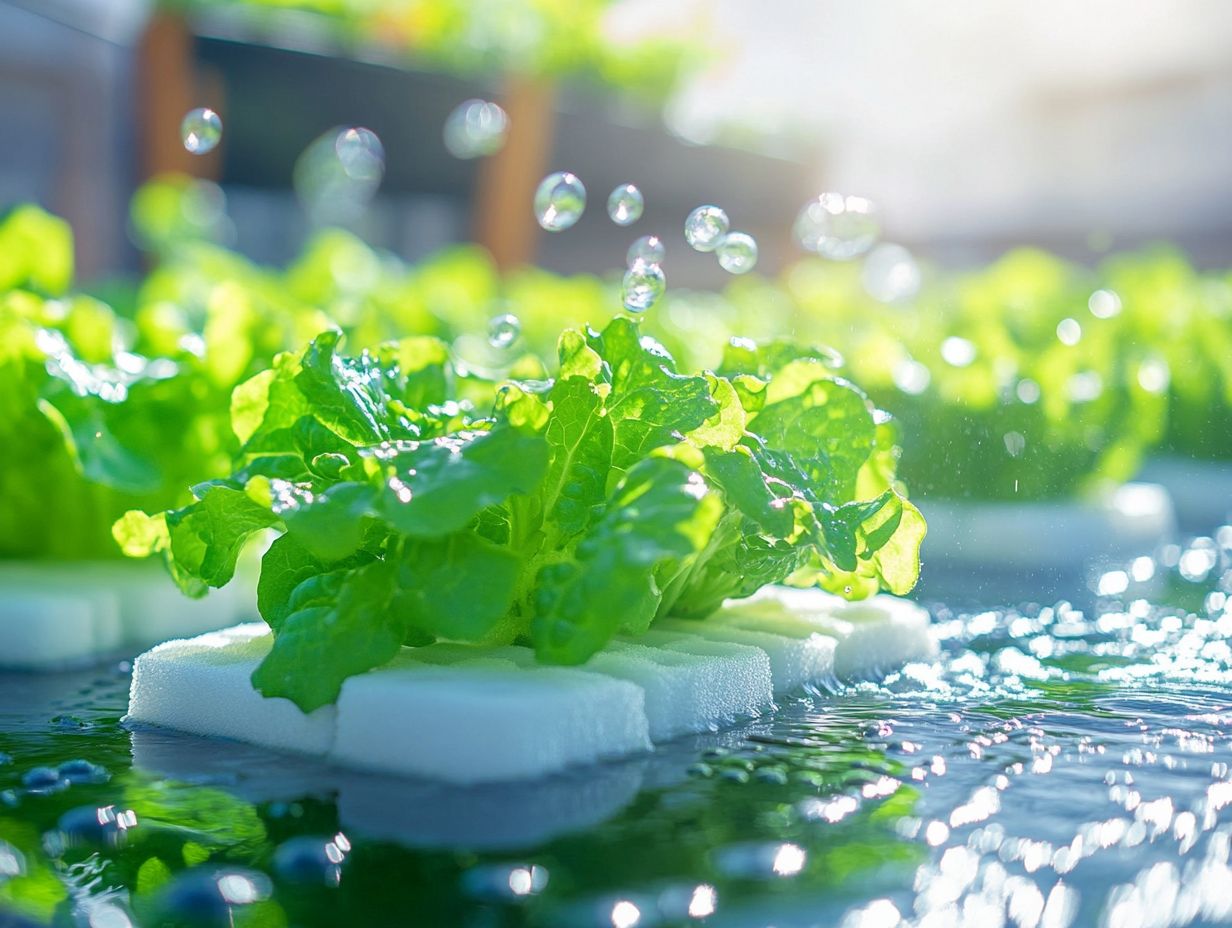
What is Deep Water Culture in Hydroponics?
Deep Water Culture (DWC) is a hydroponic method where plants are grown in a nutrient-rich solution, with their roots submerged in water and receiving optimal oxygen.
How does Deep Water Culture work?
In Deep Water Culture, plants are placed in net cups filled with a suitable growing medium. Their roots hang down into a reservoir of oxygenated water and nutrient solution. The plants absorb essential nutrients and oxygen directly from the water.
What are the benefits of using Deep Water Culture in Hydroponics?
Deep Water Culture promotes faster growth and larger yields compared to traditional soil gardening. It is perfect for both beginners and seasoned gardeners. You’ll love how quickly your plants grow! This method uses less water and space, and it also lowers the risk of soil-borne diseases and pests. Don’t miss out on the amazing benefits of Deep Water Culture!
What types of plants can be grown using Deep Water Culture?
Most leafy greens and herbs thrive in Deep Water Culture. Larger plants like tomatoes, cucumbers, and peppers can also flourish, especially with advanced techniques (Recirculating Deep Water Culture).
How do I set up a Deep Water Culture system?
To set up a Deep Water Culture system, gather a reservoir, air pump, air stone, net cups, growing medium, and a pH and nutrient testing kit. You can find detailed instructions online or at a hydroponics supply store.
What are some common mistakes to avoid when using Deep Water Culture?
Common mistakes include failing to monitor and adjust pH and nutrient levels. Using poor-quality water and overcrowding plants can also reduce the effectiveness of your system. Regular cleaning and maintenance are crucial to prevent harmful bacteria and algae from growing.

